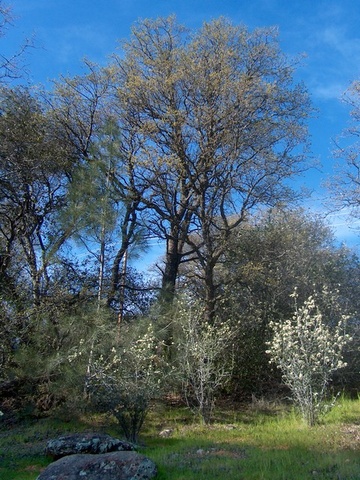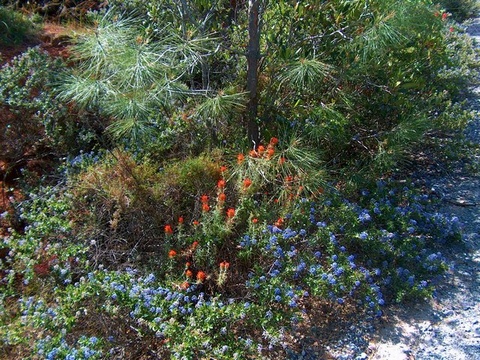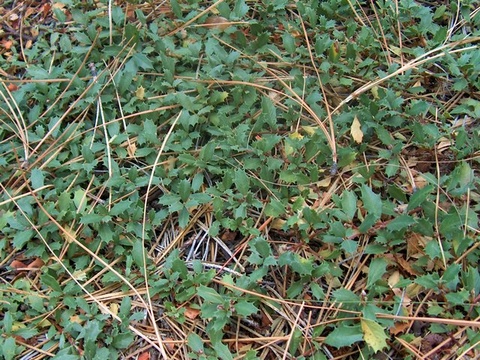California Lilacs are shrubs in the Ceanothus genus of the buckthorn family. Many of them are native to the Yuba-Sutter area. Although they are related to buckthorns, they have showier flowers and require better drainage. California lilacs are the larval host plants for the local California tortoiseshell and pale swallowtail butterflies.
Buckbrush
 Several buckbrush (Ceanothus cuneatus) shrubs bloom with white flowers under oak and pine trees near Smartsville. Photo by queerbychoice. Buckbrush (also called wedgeleaf California lilac) is a ten-foot-tall by five- to eight-foot-wide, white-flowering, evergreen shrub that is native to Yuba and Sutter Counties and typically grows at elevations below 6,000 feet. It is most often found on dry fans, slopes, and ridges in central oak woodland or yellow pine forest. It prefers full sun.
Several buckbrush (Ceanothus cuneatus) shrubs bloom with white flowers under oak and pine trees near Smartsville. Photo by queerbychoice. Buckbrush (also called wedgeleaf California lilac) is a ten-foot-tall by five- to eight-foot-wide, white-flowering, evergreen shrub that is native to Yuba and Sutter Counties and typically grows at elevations below 6,000 feet. It is most often found on dry fans, slopes, and ridges in central oak woodland or yellow pine forest. It prefers full sun.
You can read more about it at the Theodore Payne Wiki, the Las Pilitas Nursery website, and USDA Conservation Plant Characteristics. You can see pictures of it at CalPhotos, Flickr, and Picasa. You can find out where to buy it at the California Native Plant Link Exchange.
Trailing Buckbrush
Trailing buckbrush is a prostrate, white-flowering, evergreen shrub that is native to Yuba and Sutter Counties.
You can see pictures of it at CalPhotos, Flickr, and Picasa. You can find out where to buy it at the California Native Plant Link Exchange.
Lemmon's California Lilac
 Lemmon's California lilac (Ceanothus lemmonii) blooming with blue flowers, accompanied by red paintbrushes and a young yellow pine tree. Photo by queerbychoice. Lemmon's California lilac is a three-foot-tall by three-foot-wide, blue- or occasionally white-flowering, evergreen shrub that is native to Yuba County and typically grows at elevations between 1,000 and 3,500 feet. It is most often found on slopes in central oak woodland or yellow pine forest. Botanist Alice Eastwood collected Lemmon's California lilac near Texas Hill Road in 1930.1
Lemmon's California lilac (Ceanothus lemmonii) blooming with blue flowers, accompanied by red paintbrushes and a young yellow pine tree. Photo by queerbychoice. Lemmon's California lilac is a three-foot-tall by three-foot-wide, blue- or occasionally white-flowering, evergreen shrub that is native to Yuba County and typically grows at elevations between 1,000 and 3,500 feet. It is most often found on slopes in central oak woodland or yellow pine forest. Botanist Alice Eastwood collected Lemmon's California lilac near Texas Hill Road in 1930.1
You can read more about it at the Theodore Payne Wiki and the Las Pilitas Nursery website. You can see pictures of it at CalPhotos, Flickr, and Picasa. You can find out where to buy it at the California Native Plant Link Exchange.
Deerbrush
Deerbrush is a ten- to thirteen-foot-tall by eight- to ten-foot wide, white-flowering, deciduous shrub that is native to Yuba County and typically grows at elevations below 7,000 feet. It is found in yellow pine forest. It prefers full sun.
You can read more about it at the Theodore Payne Wiki, the Las Pilitas Nursery website, and USDA Conservation Plant Characteristics. You can see pictures of it at CalPhotos, Flickr, and Picasa. You can find out where to buy it at the California Native Plant Link Exchange.
Mountain Whitethorn
Mountain whitethorn (also called snowbush) is a five- to eight-foot-tall, white-flowering, deciduous shrub that is native to Yuba County and typically grows at elevations between 3,000 and 9,500 feet. It is most often found in dry areas in yellow pine forest. It prefers full sun.
You can read more about it at the Theodore Payne Wiki, the Las Pilitas Nursery website, and USDA Conservation Plant Characteristics. You can see pictures of it at CalPhotos, Flickr, and Picasa. You can find out where to buy it at the California Native Plant Link Exchange.
Mahala Mat
 Mahala mat (Ceanothus prostratus). Photo by queerbychoice. Mahala mat is a prostrate, eight-inch-tall by eight-foot-wide, blue-flowering, evergreen shrub that is native to Yuba County and typically grows at elevations between 3,000 and 8,000 feet. It is most often found on open flats in yellow pine forest. It tolerates full shade.
Mahala mat (Ceanothus prostratus). Photo by queerbychoice. Mahala mat is a prostrate, eight-inch-tall by eight-foot-wide, blue-flowering, evergreen shrub that is native to Yuba County and typically grows at elevations between 3,000 and 8,000 feet. It is most often found on open flats in yellow pine forest. It tolerates full shade.
You can read more about it at the Theodore Payne Wiki, the Las Pilitas Nursery website, and USDA Conservation Plant Characteristics. You can see pictures of it at CalPhotos, Flickr, and Picasa. You can find out where to buy it at the California Native Plant Link Exchange.
Pinemat
Pinemat is a white-flowering, evergreen shrub that is native to Yuba County and typically grows at elevations between 3,000 and 6,000 feet. It is found in yellow pine forest.
You can see pictures of it at CalPhotos, Flickr, and Picasa. You can find out where to buy it at the California Native Plant Link Exchange.


